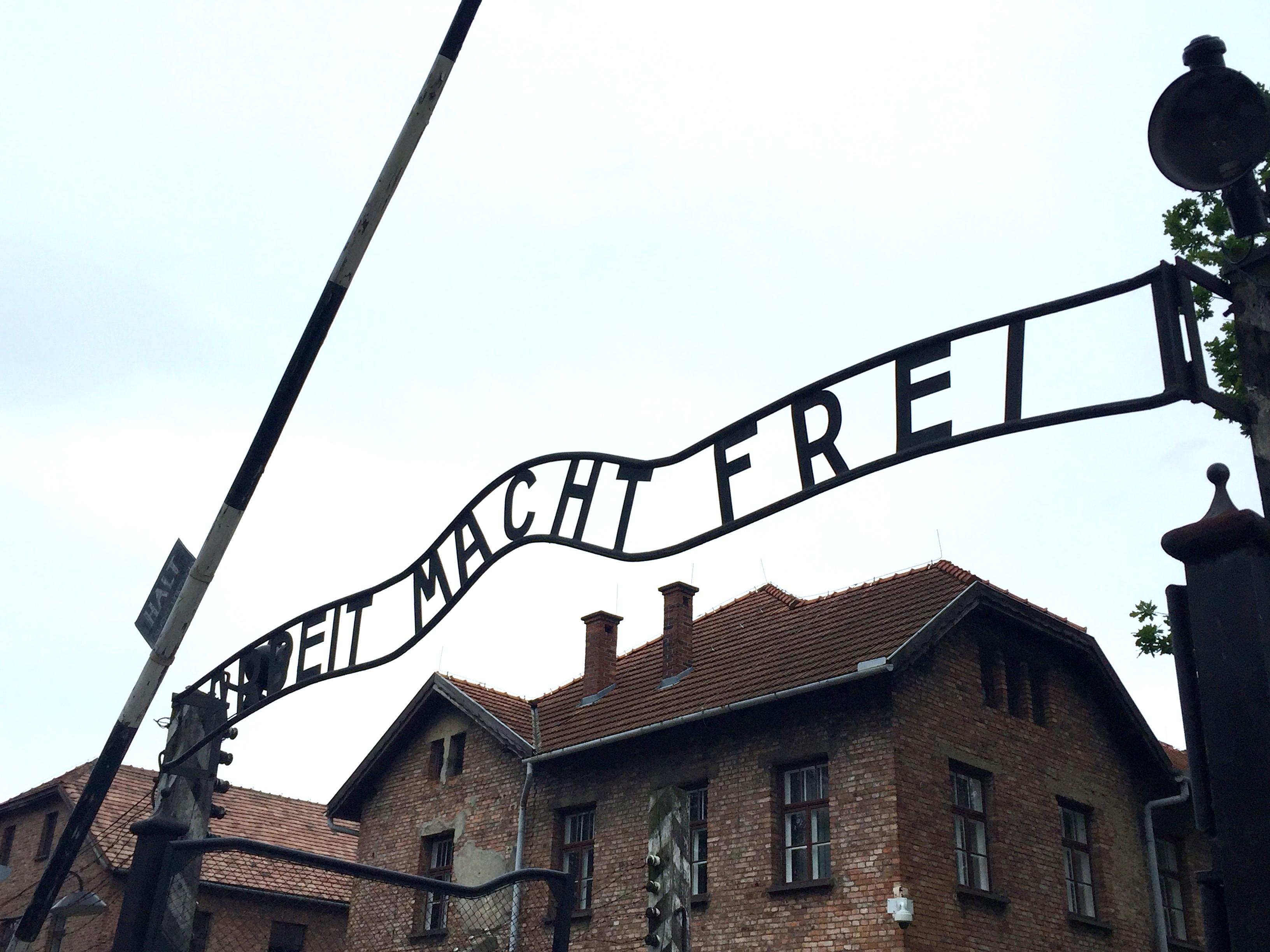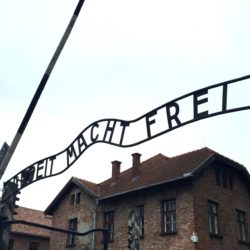While in Poland I visited the most famous (and deadly) network of concentration and extermination camps during World War II: Auschwitz I and Auschwitz II-Birkenau. Visiting the camps was one of the most gut wrenching experiences I’ve ever had. The history attributed to the camps is horrible, and seeing where everything took place adds an extra layer of depth to the stories I’ve read. There were however parts of my visit that took me by surprise, thanks to unexpected facts taught on my tour.
Camp Orchestra
While at The Schindler Museum in Krakow I learned how German Nazis did everything in their power to strip culture from Polish citizens. Therefore I was surprised to learn that when prisoners were walking into Auschwitz I they were met with a prisoners’s orchestra playing German national songs. While its purpose was to encourage the new inmates to walk in step, I found it surprising there was a camp band, especially when conditions at the camp were so horrifying. Looking around Auschwitz it seems so impossible that something as beautiful as music would ever have a place in a location so awful.
A Complex of Camps
When I thought about Auschwitz, I incorrectly assumed it was one large camp. In actually it is a network of three camps. Auschwitz I was the original camp, but when it ran out of room Auschwitz II-Birkenau was built to accommodate the influx of people. Auschwitz II-Birkeanau was initially intended solely for women, with men at Auschwitz I, but later on a section of Auschwitz I was reserved for women when Auschwitz II could no longer accommodate all the women. Auschwitz II was also where the trains would drop off prisoners, and because so many were gassed upon arrival, approximately 90% of the Auschwitz prisoners were killed here. Auschwitz III, while not available to tour, is also interesting as it is where Elie Wiesel, author of ‘Night,’ was held prisoner.
Concentration Camp vs. Extermination Camp
Before visiting Auschwitz I believed that a concentration camp and an extermination camp were the exact same thing, an incorrect assumption as each camp had a different function. An extermination camp had one purpose, and one purpose only: to murder people deemed unworthy of life in mass numbers. A concentration camp on the other hand had a variety of purposes: as a work camp, a POW camp, a reformatory facility, etc. The concentration camps treated prisoners so terribly however, that if a prisoner were to follow all rules regarding food consumption and work hours it was unlikely he or she would survive more than three months.
Buildings Already There
Something that I also found surprising was that buildings in Auschwitz I were primarily adapted from a Polish military barracks, rather than being built from scratch. While this would make more sense from a cost and time perspective, I hadn’t imagined the Nazis wanting to use something that they themselves hadn’t built, especially when they thought themselves so much superior to most nations and races. Regardless, 28 of the buildings in Auschwitz I were already standing prior to Germany’s invasion, and were easily converted into a concentration camp.
The Forgotten Holocaust
An aspect of World War II I find important to remember is that more than Jewish citizens were being persecuted. It is clear why there is an emphasis on Jewish losses, as they were tremendous: 6 million were killed in Europe, 1.1 million of which were killed in Auschwitz, a solid sixth of all deaths. But it is important to realize that other groups were also targeted.
The breakdown of Auschwitz deaths were as follows: out of the 1.3 million people total, 1.1 million were Jewish, 140,000-150,000 were Poles, 23,000 were Roma (gypsies), 15,000 were Soviet POW, and the remaining 25,000 were a mix of other races and nationalities. These numbers are approximate because bodies of prisoners were for the most part burned once they were murdered.
Of these groups, the Roma people should be highlighted: of the 23,000 Roma in Auschwitz, 21,000 were killed. In the Nuremberg Laws they were considered to be equal to jews, and over the course of the Holocaust it is estimated 220,000-500,000 Roma were murdered, slightly more than 25% of the European Roma population. My tour guide made an effort to point out that while the Jews were targeted and faced extreme tragedy, one that should be honored and remembered, it is also important to recognize that there were also other races that faced great losses and extreme genocide.
Auschwitz Album
Throughout the camps there are impactful pictures of camp life featured. These pictures were not taken by the prisoners of the camp, who had little to no possessions, but rather by the SS guards. While we do not know necessarily why SS guards took so many pictures, it helps us today visualize what the camps were like, and how prisoners were treated. These pictures are featured in the Auschwitz Album, which is currently in possession by Yad Vashem, a Holocaust museum in Israel. More pictures were initially included in the album, but some have been returned to survivors and their families.
A part of the museum was also dedicated to showing pictures of prisoners. In the early years at Auschwitz all prisoners selected for work rather than extermination entering the camp had their fingerprints and picture taken. In 1943 the SS guards stopped taking pictures of inmates due to the extremely quick death rate facing prisoners.
Impact of Relics
The most emotional part of my Auschwitz tour for me was not touring the camp itself, but rather an exhibit on what was left behind by prisoners. In this section of the museum there are multiple rooms featuring relics such as glasses, shoes, even hair, taken from the prisoners once they were murdered or imprisoned in the camp. Some of these items, such as the gold teeth, were sold, while other objects were dumped in ‘Canada,’ a portion of the camp dedicated to holding the belongings of prisons.
To me it was this section of the museum that truly drove home how many people had been brutally killed. While I can hear that 1.3 million people were killed, it’s hard to visualize that many people losing their lives. In contrast, seeing a horrifyingly large collection of hair removed from the dead helps to hit home the terrible realities of tragedies of Auschwitz, and of World War II in whole.
Auschwitz Tattoos
My understanding was that Nazis tattooed identification numbers on all prisoners in every concentration camp, right from the beginning. This was not the case. In actuality the tattooing system started as a result of Auschwitz prisoners dying so quickly. With so many corpses it was hard to identify who was who, especially once the clothes with identifying numbers were removed from the dead. To make the process easier, tattooing was introduced, but only at Auschwitz. From popular media I had wrongfully assumed it was a common practice at every camp initiated at the start of the war.
Few People Liberated
Auschwitz was liberated by the Soviets on January 27, 1945, but when the camp was liberated only approximately 7,000 people were present. In the weeks prior the SS guards began to evacuate the camps, making sure there were no prisoners left alive or evidence of the horrors committed. As a result, nine days before the Soviets liberated the camp, SS guards sent about 60,000 prisoners on a death march towards Wodzisław Śląski, where they were then sent to other camps. Roughly 15,000 prisoners died on the march.
I had thought that when the camp was liberated everyone was set free – not just those too sick or weak to make the journey. Learning this really showed me how little I knew about concentration and extermination camps as a whole. I had just assumed that prisoners were at the camp until the war was won and then everyone was sent back home. Discovering that even when it was liberated so many people that spent years at Auschwitz were still not free was heartbreaking to hear, and really added to narrative of Auschwitz.


Comments are closed